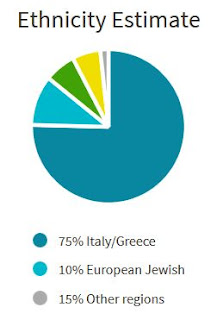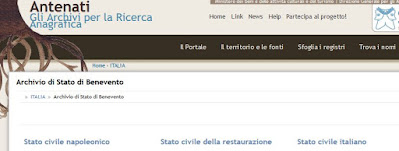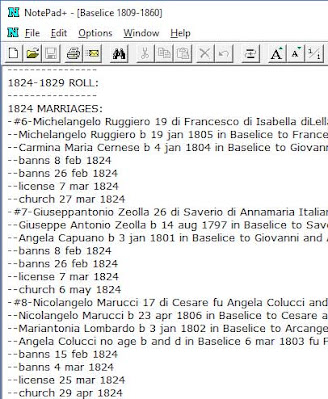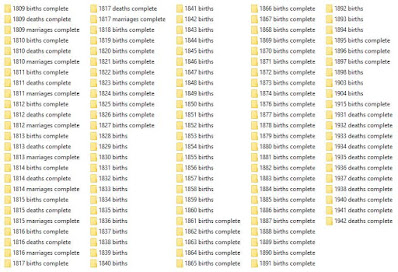I bought my DNA test from ancestry.com about five years ago, fairly soon after they made it available, and my pie chart was a bit of a shock. I've traced my ancestors back to the late 1600s, and they always lived in southern Italy. So the 44% Middle Eastern just seemed crazy.
 |
| My original pie chart and ethnicity estimate from ancestry.com. |
As time went on and more and more people submitted their DNA, the database became more robust and greater refinements were made. So now my chart is 75% Italian/Greek, and just a bit of other things. The 44% Middle Eastern is now 7%. That's a dramatic difference. So, if you get a DNA test, keep checking back for more information.
 |
| My current pie chart from ancestry.com. |
But if my ancestors were in southern Italy in the 1600s, how do I have any Middle Eastern or European Jewish DNA? Your DNA can have its origins from a thousand or more years ago, and if you think about it, the southern Italians, Europeans, and many other populations did not originate in those places thousands of years ago.
They had to come from somewhere. And what did we learn in grade school social studies? That Mesopotamia was the cradle of civilization. That everything began where the Tigris meets the Euphrates. That's modern day Iraq.
If you look at my ethnicity map and see that Italian peninsula, it doesn't seem the least bit far-fetched to think that at some point people migrated from the Middle East to the Mediterranean Sea and up into Europe. And even a little research bears this out.
 |
| In the history of things, this area isn't too spread out. |
 |
| Results from Family Tree DNA |
It's important to understand that your DNA can be different than your sibling's DNA because of the somewhat random way in which it's passed down. You have 16 great grandparents, but you will not inherit an equal amount of DNA markers from each of them. That explains why I've got more Italian DNA than my own mother.
I received a great tip at a genealogy seminar that I'll pass along to you.
If you had your DNA tested somewhere, you should be able to download the data. You can upload that data to Family Tree DNA and have another way to connect with people who may be your distant relatives. Naturally they gave me different, and less specific percentages! Now I'm looking Turkish again, but hey. The Italians had to come from somewhere originally.


